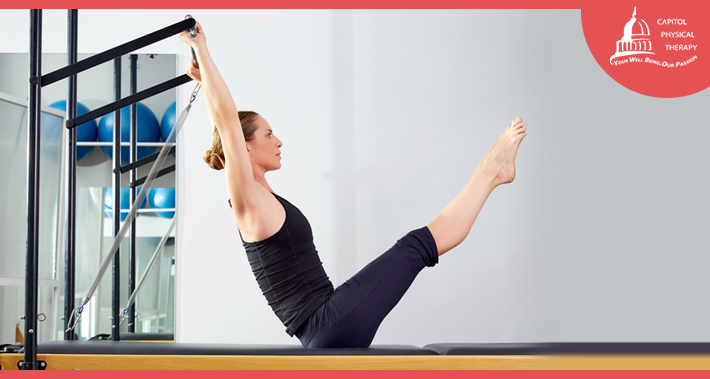
We’ve all heard how important exercise is in our daily lives.
Exercise improves physical fitness, mental health, sleep, and has many other positive impacts in our lives.
However, what you might not know is that the role of exercise is equally as important if you are undergoing cancer treatment.
In fact, it’s been shown that cancer patients and survivors who participate in physical activity experience a decrease in fatigue.
Exercising while you have cancer can also improve your ability to perform the regular day to day tasks of living.
Because of the big role exercise plays in cancer treatment, physical therapy for breast cancer and other types of cancer is also an important component of treatment.
Whether you’ve just been diagnosed, are currently undergoing treatment, or are in remission, it’s never too late to start being active.
Not only will this help your day to day life, it can also decrease your risk of developing new cancers and other co occurring illnesses.
Here at Capitol Physical Therapy in Washington DC, we work with people both during and after cancer treatment.
Let’s take a closer look at how physical therapy – and physical activity in general – can help you manage your cancer and increase your odds of staying healthy.
Is It Safe To Exercise During Cancer Treatment?
For the majority of people with cancer, exercising during treatment is completely safe.
In fact, it’s even been shown to help patients with cancer cope with the side effects of treatment.
Research has shown that physical activity during treatment may decrease your risk for developing new cancers in the future.
It’s also safe both before and after cancer treatment.
So, whether you’ve just received your diagnosis, are currently undergoing treatment, or have finished treatment and are ready to get your life back on track, exercise is a great tool.
Benefits Of Exercising During Cancer Treatment
There are lots of benefits to exercising during your cancer treatment.
Exercise can help you manage the side effects of treatment, decrease fatigue, and improve your ability to perform daily tasks.
Your physical therapist will create a personal treatment plan with you that will address your specific areas of need and limitations.
Let’s take a closer look at some of the benefits of exercise during cancer treatments.
It Keeps You Healthy Overall
We all know that exercise is an important component in staying healthy in your day to day life, and this is just as true if you are battling cancer.
In general, exercise can help by:
- Improving strength
- Improving balance
- Improving mobility
- Helping manage your weight
- Improving your quality of sleep
- Reducing insomnia
- Strengthening your bones
And it’s not just physical health benefits that exercise has.
Exercise can also improve mental health, by reducing your risk of depression and anxiety.
If you’re already active, maintaining some sort of exercise during your cancer treatment will also help you return to your normal levels of activity when your treatment is done.
It Can Improve Treatment Outcomes
Yes, you read that right.
Being active can actually improve your treatment outcomes as a patient with cancer.
Exercise has been shown to improve your body’s response to cancer treatment in a few different ways.
Firstly, exercise can decrease treatment related fatigue.
It also helps to maintain strength in your heart and lungs, which are obviously very important parts of your body.
They’re especially important during treatment.
After all, your heart pumps blood that can help deliver medications through your body and your lungs provide oxygen to your brain and body.
Regular exercise has also shown decreased hospital stays after patients who have had surgery for lung cancer.
Some studies have also associated exercise with better survival rates of breast, bladder, lung, prostate and colorectal cancers.

It’s Good For Your Mental Health
Physical activity helps you connect with your body and brain more, which has been shown to reduce depression and anxiety.
Unfortunately, but understandably, depression and anxiety are often common among cancer patients.
Being active during your treatment has been shown to improve symptoms of depression and anxiety.
It can also provide you with a feeling of control over your body, which can also improve your mental health.
Exercise also often helps people sleep better.
Your quality of sleep is usually tied to your mental health.
The less sleep you get, the more symptoms of depression and anxiety may crop up.
When you’re exercising regularly, you’re also improving your ability to sleep and therefore improving your mental health.
It Reduces Your Risk Of Other Illnesses
While it might sound too good to be true, it is actually true that exercise can help reduce the risk of developing other illnesses along with your cancer.
Exercise decreases your risk for conditions like heart disease and diabetes, which can often occur alongside certain cancers.
Exercise can also reduce your risk of developing other cancers.
Research has linked exercise to a lower risk of colon, breast, uterine, and lung cancer.
Cancer Treatment Exercise Tips
Now that you know exercise can help, you might be wondering how to go about exercising when you have cancer.
It’s important to start slowly and listen to your body when it comes to exercising during your cancer treatment.
This is true even if you were active before your cancer treatment.
Your body is experiencing new limitations of energy and possibly side effects of medications, so your tolerance for exercise may be lower than it used to be.
Your exercise tolerance may also vary day to day, which is why it’s especially important to listen to your body.
It’s important to exercise frequently, so prioritize exercising several times a week for shorter periods of time (at least ten minutes) over long stretches of exercising.
Make sure you warm up before you start exercising and stretch after to help maintain your range of motion and comfort.
Sometimes it’s also easier to add exercise to your daily routine than to plan out specific time for exercise.
This could look like:
- Walking your dog after dinner
- Walking or running on a treadmill at home
- Taking the stairs instead of the elevator
- Doing Pilates or yoga in your living room
- Using a fitness tracker like a smart watch or smart phone app to track your daily steps and try to increase them
- Going for a bike ride
- Weeding your garden
RELATED: How To Relieve Soreness After A Workout
How Can A Physical Therapist Help?
Having a physical therapist to help you come up with a safe exercise plan can be an excellent idea.
Your physical therapist can make sure you’re monitoring your body well and not doing too much or too little.
They can also help you coordinate your needs directly with your doctor and other members of your care team.
This way, everybody knows exactly what you need from exercise and how your treatment will impact you.
Physical therapist can also help you set goals and maintain a varied exercise routine to make sure you’re addressing your flexibility, strength, and stamina without overdoing it.
Book Your Appointment With Capitol Physical Therapy Today
If you’ve recently been diagnosed with cancer, you know it can be a stressful and even overwhelming time.
But you’re not alone.
Staying active throughout your cancer treatment will help you maintain a higher level of health.
Here at Capitol Physical Therapy, we can put together an exercise plan that works with your needs.
Book your appointment with Capitol Physical Therapy today.
1331 H St NW #200,
Washington, DC 20005
- https://g.page/capitolptdc
9560 Pennsylvania Ave. # 202,
Upper Marlboro, MD 20772
- https://goo.gl/maps/zjL4NnnuThRhrcS86
Capitol Physical Therapy offers orthopedic and other pain related solutions, with our versitile team of physical therapists in Washington, DC